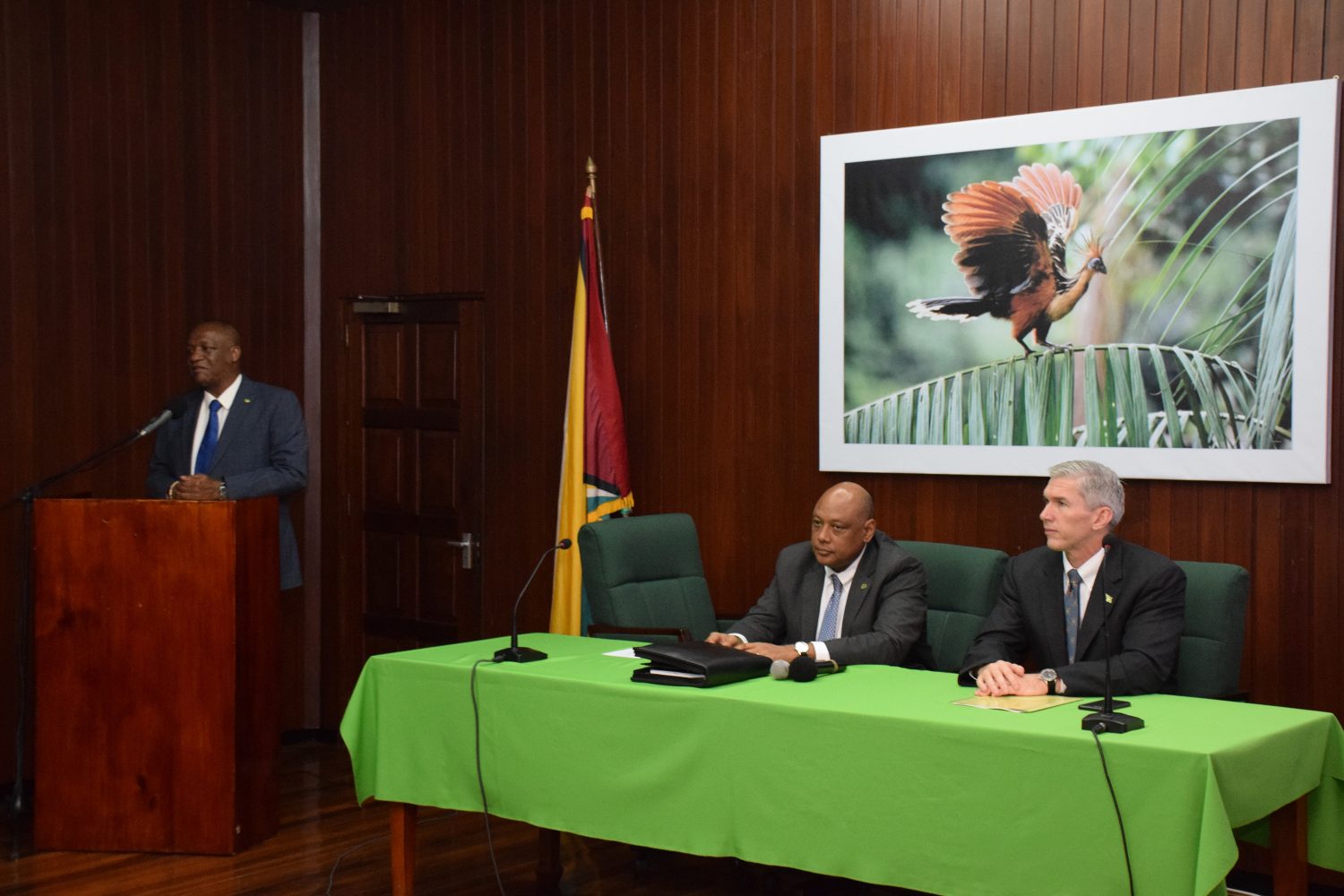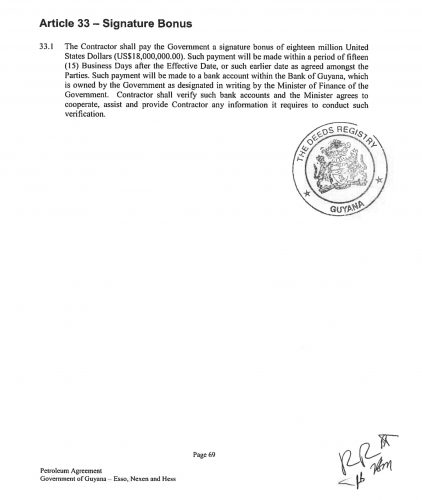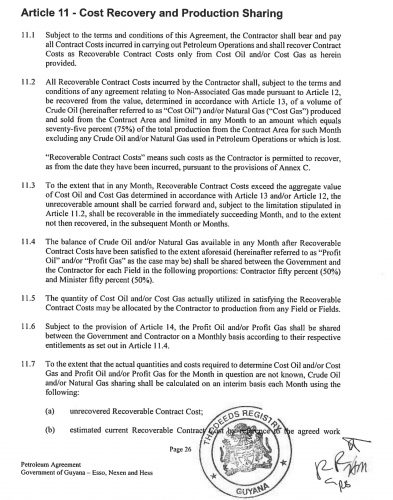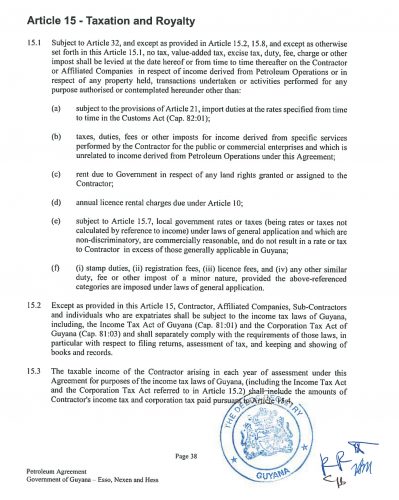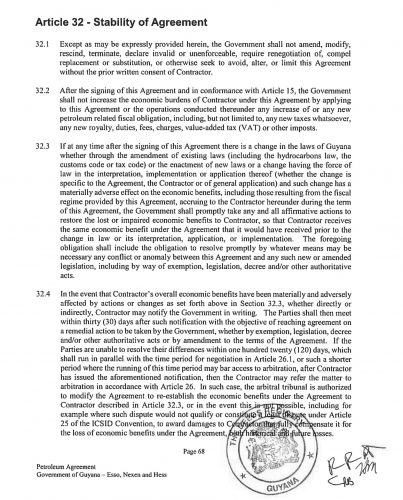-questions remain
More than a year after a new petroleum agreement was signed with ExxonMobil for works in the offshore Stabroek Block and a US$18M signature bonus received in secret, government yesterday released the contract in a blaze of publicity with both partners saying it was the best in the circumstances.
For Guyana, the 33 articles and clauses therein of the 72-page document means that revenue not previously catered for was added but analysts have pointed to a number of concessions which could be injurious to the country (see Christopher Ram column).
For ExxonMobil, a ten-year agreement which was scheduled to be up in 2018 was extended and the tax regime remains the same as in 1999 where it would not pay VAT, excise tax or duties on its operations.
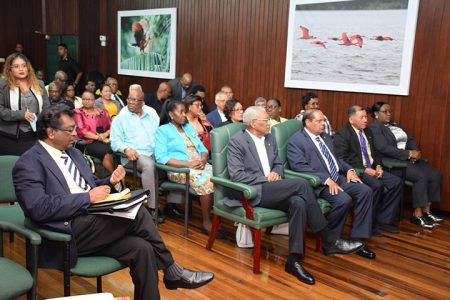
“No tax, value added tax, excise tax, duty, fee, charge or other impost shall be levied at the date hereof or from time to time thereafter on the contractor or affiliated companies in respect of income derived from petroleum operations or in respect of any property held, transactions undertaken or activities performed for any purpose authorised or contemplated,” Article 15 which speaks to Taxation and Royalty states.
A team from the IMF in a November 2017 report has said that ExxonMobil got a generous agreement from Guyana and that loopholes exist in the agreement which could see the country losing out on revenue.
According to the agreement, Exxon can also export all petroleum to which it is entitled free of any duty, tax or other financial import and can receive and retain abroad all proceeds from the sale of such petroleum.
The modified contract now sees Guyana getting a US$760,000 increase per year in rental fees, from US$240,000 to US$1M. Training funding has increased from US$45,000 to US$300,000 per annum and a new allocation of US$300,000 for social and environmental programmes has been made.
Government also boasted that it was able to introduce a two percent royalty on gross production.
Critics say the key concern about the revised 2016 agreement remains valid. Who negotiated the agreement on behalf of Guyana and was that person competent enough to secure the interests of the country?
“We received much advice from many sources …one such was that given our size as a nation, we are less than a million people, given our relative underdevelopness and our relative inexperience, we should try to stabilize our relationships rather than go out and court 15 or 16 companies coming into our waters to develop the resource,” Minister of Natural Resources Raphael Trotman told attendees at the contract release event, held at Ministry of the Presidency.
“And so it is the decision of this government that we would continue the agreement entered into by the previous PPP administration and that we would make minor modifications rather than long-term protractive negotiations with the company. We should try to manage what we have discovered, build better relations with the company and make that a long-term objective.
Rupununi Room
The government unveiled the agreement in the Rupununi Room of the Ministry of the Presidency in the presence of President David Granger, his Cabinet and other officials but without any representative of the PPP/C whose leader, Bharrat Jagdeo also boycotted.
Jagdeo later in the day would issue a release where he criticized government’s withholding of the contract for over a year saying that it was kept quiet because of the $18M signing bonus received.
But Trotman and Country Manager of ExxonMobil, Rod Henson, who also spoke at the event, said that while the US$18M bonus was an additional benefit, the contract was modified to jumpstart Exxon’s operations while simultaneously adding monetary value in areas where there was little or none.
For ExxonMobil, a US$18m signing bonus was paid for the 10-year extension of the pact.
Henson reminded that ExxonMobil was licensed by the then PPP/C government back in 1999 to explore the Stabroek Block and initiated oil and gas activities in 2008 where it culled and evaluated substantial seismic data. This led to the company drilling its first exploration well in 2015 named Liza 1.
But the 10-year exploration licence was scheduled to come to an end in 2018 and with a change of government which also saw an opportunity to cash in on modifications, both sides easily came to mutually acceptable agreements following brief negotiations.
Henson emphasized during his presentation that the 2016 petroleum agreement was founded on the 2012 model agreement which had been developed by the then government. The extension agreement signed with the government also allowed ExxonMobil careful appraisal of the Liza site as opposed to having to rush to complete an exploration programme before the expiry of the agreement. Henson and Trotman said it was not the hard-bargaining type of negotiations accustomed to since the company already had a legally binding contract and government and the David Granger led APNU+AFC government respected that.
“It was not the negotiation that we are accustomed to where we sit and have long back and forth … but we did make some minor adjusting,” Trotman said.
The Natural Resources Minister defended the revamping of the agreement in the context of the importance of stability in the relationship with ExxonMobil. Trotman told those gathered at the Ministry of the Presidency that the government considered ExxonMobil to be a “brave” and committed partner for taking the decision to sink a well in the Liza area when others wouldn’t and this was considered in deciding to enter a long-term arrangement. He cited a parallel in Botswana striking up a long-term arrangement with De Beers after diamonds were discovered in the country.
Trotman had said previously that his government respects the “sanctity” of contracts and does not want to deter investors or be termed a pariah state since it is known for being investor friendly and lawful.
Work commitments
“Both parties could have lived with the agreement we had at the time but it was evident after the discovery there were benefits to both parties if we relooked the arrangement. In addition it secured a number of benefits for Guyana, work commitments, training, local content and increased fees and payments,” Henson stated.
“For both parties a more efficient approach to development and additional exploration, accelerated project revenues as drilling operations focus on Liza appraisals rather than exploration, time to evaluate the 2015/16 block-wide 3D seismic survey and optimize the exploration programme…significant exploration risk remains as underlined by the Skipjack (dry) well result.
He said that the contract was globally competitive and lamented that it is unreasonable to compare what Guyana has secured with more mature petroleum countries like Canada and the United States and some in West Africa. Another factor he said that should be looked at was the year, 1999, when the conditions of the contract was agreed on.
Excerpt from petroleum agreement
The Minister in his address pointed also to Skipjack’s dry hole saying that had Exxon drilled that well first they probably would not have bothered with investing further here.
“I think I should say that when we assumed office we did so days after there had been a significant find. We later in that year, 2015, got definition of that significant find and concluded that the Liza field by itself contained a minimum of 800m barrels of recoverable oil to a possible 1.4B barrels. Thereafter, Exxon drilled a well, known as Skipjack, which turned out to be dry. Anyone who is involved with mining and exploration would know that if Skipjack
had been drilled and explored first, it may have changed everything, because Exxon may have concluded that the Stabroek Basin is not a fruitful basin to explore. Drilling a well is an expensive business and could run into hundreds of millions of dollars,” Trotman stated.
But he and government are happy that the drilling results turned out the way they did that it can now boast that to date reserves of 3.2B barrels of oil are believed to be in the block. “That is more than what many many countries in the world have. Guyana is entitled to 50% of that along w
ith a 2% royalty,” Trotman posited.
Giving a breakdown, Henson pointed out that based on projections of an estimated $50 per barrel of oil Guyana would earn $1.5 billion after five years and US$7 billion over a 20-year period. But using data to make his point, Henson explained that 75 percent of the earnings would for the first four years be set aside for cost recovery.
What is in hand
Trotman said that there has been criticisms from some persons that the country could have gotten more monies from the reworked contract but while this may be the case, he believes that the focus should be on not what could be but how to develop what is in hand.
He said when oil begins to flow from the Liza well, Guyana would be receiving roughly US$1m per day or US$300m per annum.
“Some people have said the royalty should have been 10 percent or 20 percent but I wish to make some points about that. First there are different types of contracts. There is a production share and a profit share contract which was held to 1999 and there is also the royalty based contract. We were already getting 50% of the profits as an equal partner. Many countries have either the production share or the royalty we decided that we would try to enjoy the best of both worlds and were successful in convincing Exxon, even though there were no legal basis for which negotiations could pursue because there was no breach of contract. The only thing that had changed was that there was a change of discovery and of government. It was a lawful binging contract. For strategic reaso
ns we chose not to enter into new negotiations with this contract,” he said.
“Based on our efforts and our calculations we can now receive when production begins in 2020, close to $1M US per day. At the end of the year Guyana would have earned a few hundred million us dollars. This is money that would come to us on a daily basis. We also determined under no other circumstances that there will be no clearing of the block…Given the fact that I said we would earn, the value of the resource has already been set at $167B USD, and Guyana being entitled to half of that, It is sometimes bemusing to understand why there is this calling for more money when we should in fact be looking at how we will manage this resource. We are less than a million. How will we protect this resource because there will be others that will want to come and share it with us, sometimes not by choice. Those are the primary concerns of the government: how do we protect what we have,” he added.
Trotman called the release of the agreement a “signal day” in the country. He said that the revised agreement did not touch how many blocks were awarded to Exxon in the original 1999 agreement. Analysts have said that the number awarded by the then PPP/C government was far in excess of what the law caters for.
